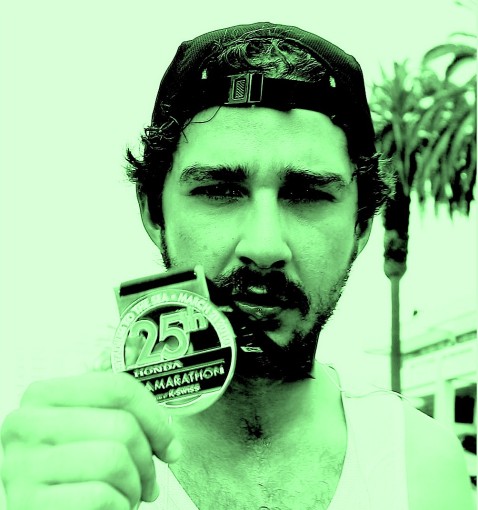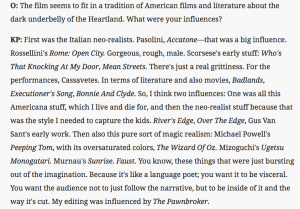
LET’S STEAL FROM THIS! How to Steal (aka Don’t Do What Shia Did)
LET’S STEAL FROM THIS! is a series of pieces looking at what fiction writers can borrow, craftily, from other sources. I will mostly look at television, movies, and comics, though the occasional literary work may sneak its way in, as will a song or two. LET’S STEAL FROM THIS! finds useful inspiration in unlikely places.
Here’s a crazy thing: I started writing this piece 7 days ago. Not with this title, obviously, but a piece about stealing vs. out-and-out thieving. A few people had asked recently what I meant by “Let’s Steal From This.” Others had wondered if I could point to an example of this principle at work. So I wrote 2,000+ words about all this, but none of it seemed very good. I was stuck and put it on hold to work on other, paying things.
Then Shia LaBeouf blessed my life, as he has blessed us all.
I won’t go through the whole weird story of what Mr. LaBeouf did — you can read it here. (Really, read it right now. The link opens in a new window.) But I thank him, for he has saved me a lot of words on the difference between stealing and theft.
It’s simple: If you take the true-life events surrounding an aging king and his daughters and you create a dramatic play of your own from them, you are stealing. (You are also Shakespeare.) This is fair game.
If you are a writer in the 20th century and you use that same play as the foundation for your modern-day novel about an aging farmer and his daughters, you are stealing. (And you are Jane Smiley.) This is also fair game — even if you don’t necessarily deepen or alter the basic characters and situation as drastically as Smiley did. Think about West Side Story, for instance.
BUT. If you make a short film using the exact same story, characters, dialogue, and themes as a work of graphic narrative and you do not obtain permission to do so nor attribute the “borrowed” parts of the work to the borrowee, this is not fair game. You are, in fact, committing plagiarism. You’re also being incredibly lazy and arrogant.
Simple, right? Well, the idea of stealing from influences can get a little complicated. Let’s break it down further…
When You Say “Steal,” What Do You Mean?
I mean finding inspiration in another work and using a piece of that inspiration to build something new. I say “steal” because “find inspiration” is flat and passive and means nothing. If I say American Hustle is “inspiring” to me as a writer, what does that even mean?
But if I say, “Hey, I like how American Hustle started at what would be its story’s midpoint and then yanked me back to the actual beginning,” that’s a useful statement. I can do something with that, and it leads me to more useful thoughts: Starting where it did gave the viewer a preview of what was to come, it set the “voice” for the movie, and it immediately threw us into the orbit of the film’s main narrator as he spends several minutes applying his hairpiece.
So would it be okay to take that structure, that order, and apply it to something you’re working on? Absolutely, unless you’re making a movie about a pair of grifters and an FBI agent who team up to entrap crooked politicians in the 1970s. Then it’s a little on the nose, as they say.
American Hustle, by the way, steals a shitload from Goodfellas. Maybe even a little too much of its technique and not enough of its soul — by the third montage where a camera swoops in on characters stepping out of a ’70s sedan while a period-appropriate song plays, you’re a little weary. But it’s definitely its own movie, not an out-and-out Goodfellas ripoff.
That’s one example of “stealing” vs. theft. Can you give another?
Sure. When the Glee pilot first aired in 2009, it was like nothing else you’d seen — unless you’d seen Alexander Payne’s 1999 film of Tom Perotta’s novel Election. From its first scenes, Glee outright lifted the technique of multiple character voiceovers from both the book and film of Election. It also seems to have borrowed its midwestern setting, its sad-sack high-school teacher, dumb football guy and abrasive, ambitious, self-aggrandizing girl. (Lea Michelle’s character is Tracy Flick with a great voice.) I remember watching the first minutes of Glee and thinking: What the fuck? Is this Election on TV? Within the next minutes, though, Glee proved itself to be a very different animal. In borrowing from the style and tone of Election — and in making something new from those elements — it showed taste and intelligence, not cowardice.
It is worth noting that Glee steered clear of school-election storylines for at least a full season.
It is ALSO worth noting that while Glee was smart in how it borrowed from Election, its musical track record is flat-out awful. There are multiple instances of Glee straight-up stealing highly recognizable arrangements from other sources, with zero credit, payment, or acknowledgement. (If you read just one of those links, make it the Coulton piece on Wired. It’s a doozy.)
Contrast this with Kaavya Viswanathan’s 2006 novel How Opal Mehta Got Kissed, Got Wild, and Got a Life, in which the author was discovered to have lifted entire sections — sometimes verbatim, sometimes with just a few words’ difference — from Megan McCafferty, Salman Rushdie, Meg Cabot, Sophie Kinsella, and Tanuja Desai Hidier. In the case of McCafferty’s work, there were 40 passages that were found to be identical or nearly identical to material from two of her novels, including dialogue, description, plot points, and scenes. In the case of Rushdie’s material, it gets bizarre: Viswanathan seems to have slightly reworded two rhyming warning placards from Rushdie’s Haroun and the Sea of Stories that then appear in two places in her book. But it all worked out okay. The book was recalled and destroyed, and Viswanathan is now a practicing lawyer with a degree from Georgetown.
So you can’t steal a scene?
No, you can. I think McCafferty et al certainly have it over Viswanathan in terms of linguistic theft (here’s the Wikipedia breakdown), but stylistic theft is a slippery animal. Would we have rock & roll without it? Even blues is evolved from, I’m sorry, ancient European ballad traditions that’d stayed alive in the American South. I mean, you know a lot of the Old Testament stories are repurposed versions of earlier stories, right? And then there’s the whole Jesus/Horus rabbit hole.
So yes, you can steal a scene. Steal the shit out of a scene. Just don’t copy the names and the words. Is that so hard?
Come on, really?
Really. BUT, and there’s always a but, you have to make something new out of it. I have a student who wants to use the opening lecture-hall scene from The Paper Chase. Instead of a law professor belittling a too-bold first-year student, he wants to use the basic setting (a speaker in a university lecture hall) to introduce his main villain, a hedge fund billionaire. I told him to go for it, because a) he’s not using the same characters or dialogue, just the same situation; and b) his next scene features someone carrying out a murder ordered and paid for the billionaire guest speaker in the lecture hall, which immediately departs from any territory the story might’ve shared with The Paper Chase.
How many stories do you think there are? How many situations or “turns” do you think there are? Go into a bookstore, if you can find one near you, and ponder this as you look over the shelves and shelves of novels both new and old. In each of those novels, a main character will have a steadfast idea about the way the world works, and that idea will be proven wrong. In each, he or she will have a scene where they surprise themselves or others with an ability or empathy they didn’t know they had. In each, there will be a scene where our hero risks everything. (Or where our hero pointedly fails to risk everything.) None of these books was the first to do this. Most of them have borrowed from each other, or from even more ancient sources.
Why I call this column Let’s Steal From This! is because of the very first advice I got from Sheila Kohler, my very first teacher in grad school: When reading anything, no matter what, ask yourself: “What’s something I can steal from this?” In our reading annotations, we weren’t allowed to answer “nothing.” While the main purpose of this was to force us to read with more thought about craft, there was a bonus feature: we read with more empathy. Our job, after all, was to find the good in a thing, versus dismissing the whole work entirely. This is not always easy, but it’s essential.
Can I steal from more than one thing at a time?
Yes, and you should. Let’s be clear: you will anyway, since we’re all a sum of our influences. Being aware of this will not only to protect you from the temptation to do What Shia Did, but will also help you make a better, more interesting piece of work.
There’s a great interview with Kimberly Peirce, the director of Boys Don’t Cry, where she talks to the AV Club about her influences in making the film. What’s great about it is how specific she gets, and how upfront she is about what she took from whom: She “stole” editing techniques from The Pawnbroker for use in one scene, she “stole” early Scorsese techniques for other parts, she took . But the film never feels like it’s anyone’s but Kimberly Peirce’s, because she carefully selected what she was taking, and she put limits on it. Most importantly, she had a vision for how these things would go together. Here’s a snapshot of that discussion (click to enlarge):
Isn’t that fantastic? I first read that in 1999 and have never forgotten it. Kimberly Peirce knew exactly what was informing her movie, yet if you watch that movie it looks like none of those things. It looks like Boys Don’t Cry.
That’s how you do it, poor, stupid Shia LaBeouf, that’s how you do it. That’s how you make a creative work. Anything else, if I may repurpose Truman Capote’s famous putdown of Jack Kerouac, is just typing.


